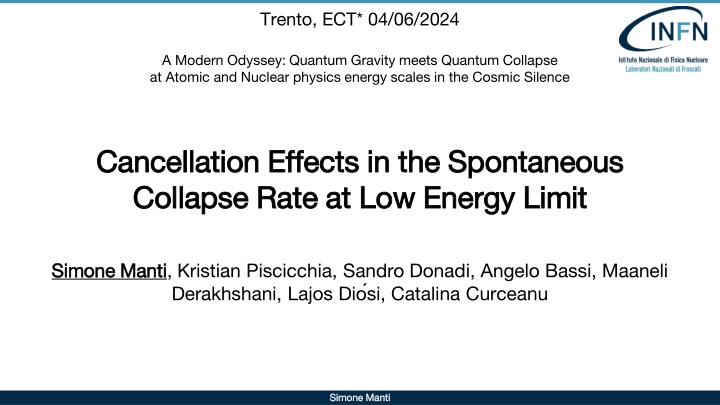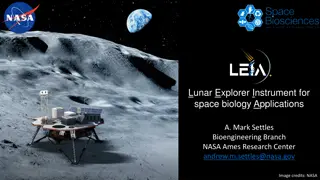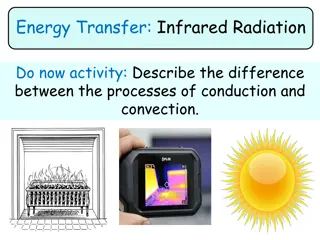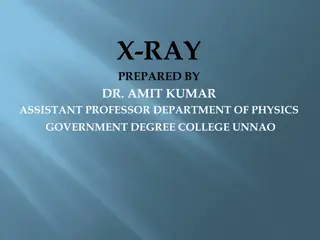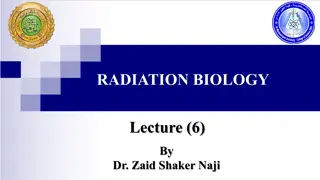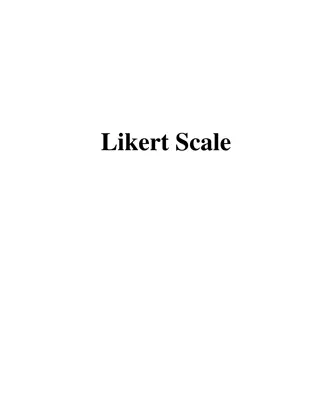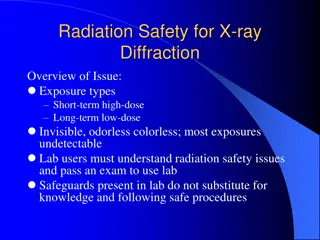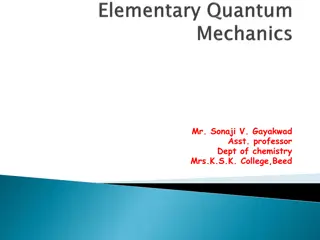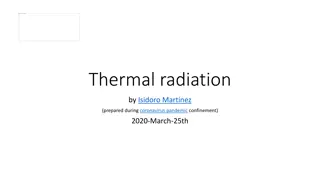Investigating Quantum Collapse and Spontaneous Radiation at Low Energy Scales
Delve into the realm where Quantum Gravity meets Quantum Collapse, exploring the Cosmic Silence Cancellation Effects and the Spontaneous Collapse Rate at Low Energy Limits. Models like Continuous Spontaneous Localization and Dio.si-Penrose propose solutions to the macroscopic observation challenge in Quantum Mechanics, inducing spontaneous electromagnetic radiation in X-ray domains. Current models seek refinement for accurate low-energy behavior analysis, addressing previous experiments with high purity germanium crystals and challenges in predicting radiation at lower energy scales.
Download Presentation

Please find below an Image/Link to download the presentation.
The content on the website is provided AS IS for your information and personal use only. It may not be sold, licensed, or shared on other websites without obtaining consent from the author.If you encounter any issues during the download, it is possible that the publisher has removed the file from their server.
You are allowed to download the files provided on this website for personal or commercial use, subject to the condition that they are used lawfully. All files are the property of their respective owners.
The content on the website is provided AS IS for your information and personal use only. It may not be sold, licensed, or shared on other websites without obtaining consent from the author.
E N D
Presentation Transcript
Trento, ECT* 04/06/2024 A Modern Odyssey: Quantum Gravity meets Quantum Collapse at Atomic and Nuclear physics energy scales in the Cosmic Silence Cancellation Effects in the Spontaneous Cancellation Effects in the Spontaneous Collapse Rate at Low Energy Limit Collapse Rate at Low Energy Limit Simone Manti Simone Manti, Kristian Piscicchia, Sandro Donadi, Angelo Bassi, Maaneli Derakhshani, Lajos Dio si, Catalina Curceanu Simone Manti Simone Manti
Outline Outline Cancelation Effects in the Spontaneous Collapse Rate Cancelation Effects in the Spontaneous Collapse Rate Rates for CSL and DP in the Low Energy Limit Rates for CSL and DP in the Low Energy Limit Different Approximations in the Low Energy Limit Different Approximations in the Low Energy Limit Simone Manti Simone Manti
Quantum Mechanics: Quantum Mechanics: Allows precise predictions, but superposition principle isn't observed in macroscopic systems. Collapse Models: Collapse Models: Propose that quantum mechanics' linearity breaks down at a certain scale to solve the measurement problem. Key Models: Key Models: Continuous Spontaneous Localization (CSL) Dio si-Penrose (DP) (DP) (CSL) Goal: Goal: Investigate spontaneous electromagnetic radiation in X-rays domain induced by dynamical wave-function collapse. Donadi, Sandro, et al. "Underground test of gravity-related wave function collapse." Nature Physics 17.1 (2021): 74-78. Simone Manti Simone Manti
Collapse Models introduce stochastic terms in Schrdinger's Equation Collapse Models introduce stochastic terms in Schr dinger's Equation Collapse Mechanisms: Collapse Mechanisms: Both CSL and DP models introduce non-linear, stochastic terms in Schr dinger's equation. Spontaneous Radiation: Spontaneous Radiation: Random collapses induce radiation due to random acceleration of charged particles. Energy Domains: Energy Domains: Previous studies focused on -rays; this study focuses on X- rays. Simone Manti Simone Manti
Current models need refinement for low Current models need refinement for low- -energy behavior analysis energy behavior analysis Previous Experiments: Previous Experiments: - - - -rays: rays: High purity germanium crystals used to compare measured radiation with theoretical predictions. - - X X- -rays: rays: Studies at lower energies to probe different aspects of wave-function collapse. Challenges: Challenges: Current models' predictions need refinement for accurate low-energy behavior analysis. Simone Manti Simone Manti
Atomic Scale in the CSL model Atomic Scale in the CSL model CSL Model: CSL Model: - Spontaneous emission rate considering atomic scale. - Equation involves parameters: (strength), rC(correlation length). - Rate derivation in Donadi, Sandro, et al. "Novel CSL bounds from the noise- induced radiation emission from atoms." The European Physical Journal C 81.8 (2021): 1-10. Simplest Approximation: Simone Manti Simone Manti
Atomic Scale in the CSL model: Semiclassical Approach Atomic Scale in the CSL model: Semiclassical Approach Nucleus Nucleus- -Nucleus: Nucleus: Nucleus Nucleus- -Electron: Electron: Electron Electron- -Electron: Electron: Simone Manti Simone Manti
Atomic Scale in the CSL model: Semiclassical Approach Atomic Scale in the CSL model: Semiclassical Approach Nucleus Nucleus- -Nucleus: Nucleus: Nucleus Nucleus- -Electron: Electron: Electron Electron- -Electron: Electron: Simone Manti Simone Manti
Atomic Scale in the CSL model: Semiclassical Approach Atomic Scale in the CSL model: Semiclassical Approach Parametrizion used: =2, =0 Isolated Ge atom - DFT (LDA) Simone Manti Simone Manti
Atomic Scale in the CSL model: Semiclassical Approach Atomic Scale in the CSL model: Semiclassical Approach Generalization to the non-Markovian case: Simone Manti Simone Manti
Atomic Scale in the DP model Atomic Scale in the DP model The Rate for a Markovian DP model has instead: fijis a measure of the overlap between the mass densities of the particles i-th and j-th (gi,j) Simplest Approximation: Simone Manti Simone Manti
Atomic Scale in the DP model: Semiclassical Approach Atomic Scale in the DP model: Semiclassical Approach Simone Manti Simone Manti
Different Models give Different Rates in the Low Energy Limit Different Models give Different Rates in the Low Energy Limit Simone Manti Simone Manti
Validity of the Semiclassical Approach Validity of the Semiclassical Approach Nucleus Nucleus- -Electron: Electron: Electron Electron- -Electron: Electron: Simone Manti Simone Manti
Limits on Limits on ? ?: Helium case ( : Helium case (1 1s s2 2) ) Radial Radial Distribution Distribution Function Function probability distribution to find two electrons at u u 1s 0.946 (1) 1s[a.u.] [a.u.] 2 2 1 1s s[a.u.] 1.892 (2) [a.u.] <r <r12 1.30 (1.35) 12> >uncorrelated uncorrelated <r <r12 1.41 (1.47) 12> >correlated correlated Simone Manti Simone Manti
Limits on Limits on ? ? and and ? ?: Lithium case (1s : Lithium case (1s2 22s 2s1 1) ) Radial Radial Distribution Distribution Function Function probability distribution to find two electrons at u u 1s 1s[a.u.] [a.u.] 2s 2s[a.u.] [a.u.] | | 1s 1s- - 2s 2s| [a.u.] | [a.u.] <r <r12 12> >1s 1s [a.u.] [a.u.] <r <r12 12> >1s 2s[a.u.] [a.u.] 1s- -1s 1s- -2s 0.582 3.908 3.32 0.6 3.2 ROHF/6-311G Simone Manti Simone Manti
Limits on ? ? and ? ?: Beryllium case (1s22s2) probability distribution to find two electrons at u Position intracule 1s[a.u.] 2s[a.u.] | 1s- 2s| [a.u.] <r12>1s-1s [a.u.] <r12>1s-2s[a.u.] <r12>2s-2s[a.u.] 0.421 2.604 2.18 0.5 2.1 2.9 ROHF/6-311G Simone Manti Simone Manti
Rate formula Germanium Rate formula Germanium ? ?=1.5 (1,2) and =1.5 (1,2) and ? ?=1 (0.9,1.1) =1 (0.9,1.1) Simone Manti Simone Manti
Fully Quantum approach for Low Energy Limit Fully Quantum approach for Low Energy Limit The general structure for the formula Rate is: This can be rewritten in terms of the Radial Distribution Function Radial Distribution Function (RDF) of the emitters: Where is the probability to find two emitters i and j at distance r Electron Electron- -Nuclear RDF Nuclear RDF Electron Electron- -Electron RDF Electron RDF Simone Manti Simone Manti
Conclusion Conclusion Cancelation Effects due to the atomic scale in the Collapse Cancelation Effects due to the atomic scale in the Collapse Rate Rate Different Rates for CSL and DP due to Cancelation Effects Different Rates for CSL and DP due to Cancelation Effects Fully Quantum Scheme for Rate Calculations with RDF Fully Quantum Scheme for Rate Calculations with RDF Thanks for your Attention! Simone Manti Simone Manti
